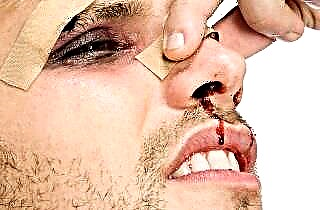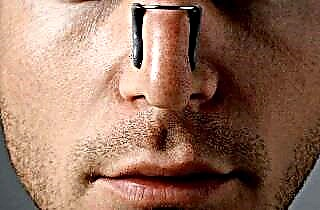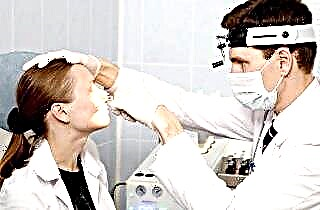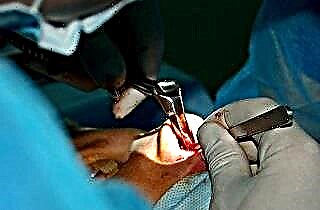A crooked nasal septum is a problem for almost 90% of the world's population. However, most people live with it quite successfully, do not feel any discomfort, and sometimes do not even suspect that they have such a pathology. A deformity in the nose can be completely invisible from the outside and not have any negative effect on the body. In this case, you do not need to take any measures to eliminate it. However, there are situations when the patient feels unpleasant symptoms and even acquires chronic diseases associated with a deviated septum.
Functions and structure
 A septum is needed in the nose to evenly distribute the air flows that a person inhales. It divides the cavity into two approximately equal parts. This helps to organize the correct entry of oxygen into the alveoli and its further distribution throughout the body. The jumper in an adult consists of cartilage and bone tissue. In babies, it is very plastic, since it has a cartilaginous basis and only in some places there are disseminations of bone "islets", which further grow. Membrane structure:
A septum is needed in the nose to evenly distribute the air flows that a person inhales. It divides the cavity into two approximately equal parts. This helps to organize the correct entry of oxygen into the alveoli and its further distribution throughout the body. The jumper in an adult consists of cartilage and bone tissue. In babies, it is very plastic, since it has a cartilaginous basis and only in some places there are disseminations of bone "islets", which further grow. Membrane structure:
- quadrangular cartilage in the anterior section;
- opener in the rear section;
- perpendicular plate of the ethmoid bone in the posterior section.
Causes of deformation
Congenital curvature of cartilage is quite rare, children are mostly born with a perfectly flat septum. Curvature most often appears in adolescence, from about 12 to 16 years old, when all organs and systems are actively developing and growing. However, statistics say that when the nose is injured, this violation occurs in most of all cases. Let us consider in more detail what causes the curvature of the nasal septum.
- Active and uneven tissue growth. When the facial and cerebral skulls grow disproportionately, it can happen that parts of the nose simply have nowhere to go. This causes the curvature of the septum and other departments. Most often, the facial bones develop more slowly than the cranial bones, therefore, under the pressure of the small "frame" that holds the nose, it begins to bend.
- Neoplasms. Benign and malignant tumors also lead to deviation of the septum from the axis. They press on the mucous membranes, cartilage and bone tissue, causing the curvature of the nasal septum in children and adults.
 Inflammation. Chronic inflammatory processes and some systemic diseases can lead to bone necrosis of the facial skull. This negatively affects the structure and shape of the nasal septum.
Inflammation. Chronic inflammatory processes and some systemic diseases can lead to bone necrosis of the facial skull. This negatively affects the structure and shape of the nasal septum.- Injury. The most common cause of curvature of the nasal septum. During a strong blow, the bones not only deform, but also break. This violation can even be fatal. Pieces of broken bones penetrate the bloodstream and the respiratory system, and sometimes cause severe bleeding, from which a person can simply choke if he is not helped in time.
Types of violations
Regardless of what the causes of the curvature of the nasal septum were, they can have different locations and differ in their shape. Determination of the location is necessary for the selection of the correct therapy. Deformation has the following varieties:
- curvature in the form of the letter S or C, in which bends are formed;
- crest - an oblong flat outgrowth;
- thorn - a pointed convex growth.
Most often, patients are faced with a mixed pathology, when both bone and cartilage tissue are affected at once, and the curvature is of a mixed type. Such violations can be corrected only with the help of a special operation.
A deviated nasal septum can be seen with the naked eye, especially when it comes to S-shaped deformity, but most often it is diagnosed only after examination.
What does the patient feel
If the septum is curved, the patient may not feel anything at all. There are times when a strong displacement of tissues does not cause discomfort and does not affect health in any way. But it also happens that the slightest violation causes a number of unpleasant symptoms and serious complications.
Deformation can be recognized by the following features:
- Breathing problems. The patient may feel difficulty breathing air from one or both sides, in some cases, there is a complete blockage of the nostril. The condition is dangerous by the development of such complications as oxygen starvation, during which work capacity, physical endurance and mental activity are significantly reduced.
 Distinctive sound during sleep. A crooked septum causes snoring. Such a violation not only causes discomfort to everyone who lives with the patient, it can provoke a short-term complete cessation of breathing.
Distinctive sound during sleep. A crooked septum causes snoring. Such a violation not only causes discomfort to everyone who lives with the patient, it can provoke a short-term complete cessation of breathing.- Inflammatory processes in the nose and nearby organs. The displacement of the cartilage and bones of the septum leads to the appearance of inflammatory processes. They begin on the nasal mucosa, but can easily spread to the paranasal sinuses, auditory tube, and lacrimal canals. Closely located organs suffer from a drop in local immunity and dysfunction, therefore sinusitis, rhinitis, inflammation of the lacrimal pocket and the Eustachian tube appear. In some cases, a middle ear infection causes hearing loss, which may be complete or partial.
- Figurative curvature. The curvature of the nasal septum in a child leads to the fact that he begins to breathe through his mouth, the so-called "adenoid" facial expression appears, when the nasolabial fold is smoothed out, flabbiness and distortion of features appear.
- The appearance of neoplasms. Since the curvature of the nose causes constant irritation of the mucous membranes, tissues can degenerate and thicken, forming polyps. These tumors are best removed as they cause serious disruption to the body.
- Loss of smell. The nasal septum, the curvature of which is very strong, may come into contact with the olfactory center located in the nose. This causes a reversible or irreversible loss of the sense of smell.
There are many other symptoms that indicate a disorder. However, they can all be a consequence of other diseases. In any case, if you find at least one sign, you should consult a doctor.
It is especially dangerous when the curvature of the cartilaginous or bony part of the nasal septum is observed in children. This condition can cause developmental delays, as the brain does not receive enough oxygen, and in some cases, respiratory arrest.
How to recognize a violation
An otolaryngologist can diagnose a curvature of the nasal septum. A violation is detected using various diagnostic techniques. Basically, to get a complete picture of the pathology, doctors perform the following manipulations:
 Taking anamnesis from the patient's words. The patient tells the doctor in detail about his feelings and their characteristics, the presence of concomitant diseases. It is also important that all nose injuries, if any, are indicated on the card.
Taking anamnesis from the patient's words. The patient tells the doctor in detail about his feelings and their characteristics, the presence of concomitant diseases. It is also important that all nose injuries, if any, are indicated on the card.- Visual inspection. Curvature and deformation of the nasal septum is determined in some cases even by visual examination. Spikes and ridges, as well as C or S-shaped misalignment, are determined at this stage if the violation is very serious.
- Palpation. Probing is carried out in order to identify pathologies in the structure of cartilaginous tissues and nostrils. In some cases, palpation reveals a deformity that is not visualized.
- Instrumental research.This is a rhinoscopy, which can be posterior or anterior. Most often, the second variant of research is sufficient to clarify all the features of the violation. If a more thorough revision of the nasal cavity is required, a posterior rhinoscopy is performed.
- Hardware techniques. With complex pathologies, especially after injury, the patient is assigned a tomography or X-ray examination. In the pictures, you can see not only the features of the septum, but also the presence of infections in the paranasal sinuses.
After a detailed study of the deformation itself, the doctor may prescribe additional consultations and studies. A general chemical analysis is required, it gives an idea of the presence of infections and the degree of their development. Mucus is taken from the nostrils and checked for bacteria. Cytological studies and testing by an immunologist-allergist can also be carried out.
Troubleshooting methods
No amount of ointment or heating will help get rid of the defect. Only a surgical intervention gives high results and significantly alleviates the condition of patients. To temporarily relieve severe symptoms, the following medications may be prescribed:
- antibiotics;
 vasoconstrictor drops and sprays;
vasoconstrictor drops and sprays;- antihistamines, etc.
However, neither these drugs nor traditional medicine can give a lasting effect, they all work as long as the course lasts, and after it, the disorder begins to show symptoms again.
Correction of a crooked nose and its septum is possible only with the help of an operation. It can be carried out using several methods, which we will consider in more detail.
- General septoplasty. To move the septum in the right direction or remove its defect, the doctor uses a scalpel, hammer and chisel. This method is highly traumatic and has a long rehabilitation period. In the first days after the intervention, the patient's body temperature may rise, the stitches may disperse, he feels severe pain from swelling of the mucous membrane. Full recovery takes several weeks. However, this method has its own advantages, it allows you to correct even the most extensive defects.
- Endoscopic septoplasty. It is performed without incisions of external tissues and suturing, therefore it requires less time for rehabilitation. An endoscope equipped with a miniature camera is inserted into the nostrils, the image is displayed on a large monitor. The doctor, with the help of special instruments, acts only on those tissues that have been deformed, healthy areas are not touched. The patient is discharged on the second day after the operation.
- Laser correction. Laser beam targeting is a new technology for bloodless surgery. The high temperature inside the beam leads to the fact that all vessels that meet in its path are instantly sealed. After surgery, the appearance of edema and hematomas is minimized. The procedure itself is carried out for about a quarter of an hour under local anesthesia, after which the patient can immediately go home. A significant disadvantage of the technique is the ability to act only on cartilaginous tissues; in relation to bone deformation, it is ineffective.
Consequences of untimely treatment
 If the causes and symptoms of nasal septum curvature are ignored, it can lead to serious consequences. In adults, concomitant disorders most often appear at a more mature age, if the deformation occurs at a time when the body is still growing, then the nose can adapt to breathing and use its compensatory capabilities. However, in the future, all the consequences will make themselves felt.
If the causes and symptoms of nasal septum curvature are ignored, it can lead to serious consequences. In adults, concomitant disorders most often appear at a more mature age, if the deformation occurs at a time when the body is still growing, then the nose can adapt to breathing and use its compensatory capabilities. However, in the future, all the consequences will make themselves felt.
Chronic inflammatory processes develop not only in the upper, but also in the lower respiratory tract, since a person inhales polluted, dry and cold air through his mouth. This can lead to persistently recurrent bronchitis, pneumonia, pleurisy and bronchial asthma.
General oxygen starvation leads to the fact that a person cannot lead a normal active life, he is constantly lethargic and tired, unable to concentrate on anything.
Negative reactions are observed on the part of the cardiovascular system, blood pressure rises, and malfunctions of the heart occur. Women may face such a problem as a violation of the menstrual cycle.
Chronic inflammation in the middle ear can lead to complete hearing loss. To avoid all these negative consequences, you should consult a doctor in time.
Let's summarize
The nasal septum can bend at any age from the negative effects of various factors. Deformity often does not manifest itself at a young age, but it can cause many disorders in old age.
To correct the situation, you need to go to an appointment with an otolaryngologist, undergo an examination and find out all the features of the pathology. Correcting the situation is possible only through surgical intervention.

 Inflammation. Chronic inflammatory processes and some systemic diseases can lead to bone necrosis of the facial skull. This negatively affects the structure and shape of the nasal septum.
Inflammation. Chronic inflammatory processes and some systemic diseases can lead to bone necrosis of the facial skull. This negatively affects the structure and shape of the nasal septum. Distinctive sound during sleep. A crooked septum causes snoring. Such a violation not only causes discomfort to everyone who lives with the patient, it can provoke a short-term complete cessation of breathing.
Distinctive sound during sleep. A crooked septum causes snoring. Such a violation not only causes discomfort to everyone who lives with the patient, it can provoke a short-term complete cessation of breathing. Taking anamnesis from the patient's words. The patient tells the doctor in detail about his feelings and their characteristics, the presence of concomitant diseases. It is also important that all nose injuries, if any, are indicated on the card.
Taking anamnesis from the patient's words. The patient tells the doctor in detail about his feelings and their characteristics, the presence of concomitant diseases. It is also important that all nose injuries, if any, are indicated on the card. vasoconstrictor drops and sprays;
vasoconstrictor drops and sprays;

